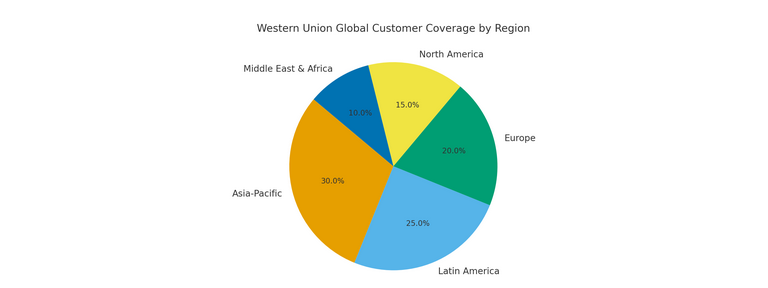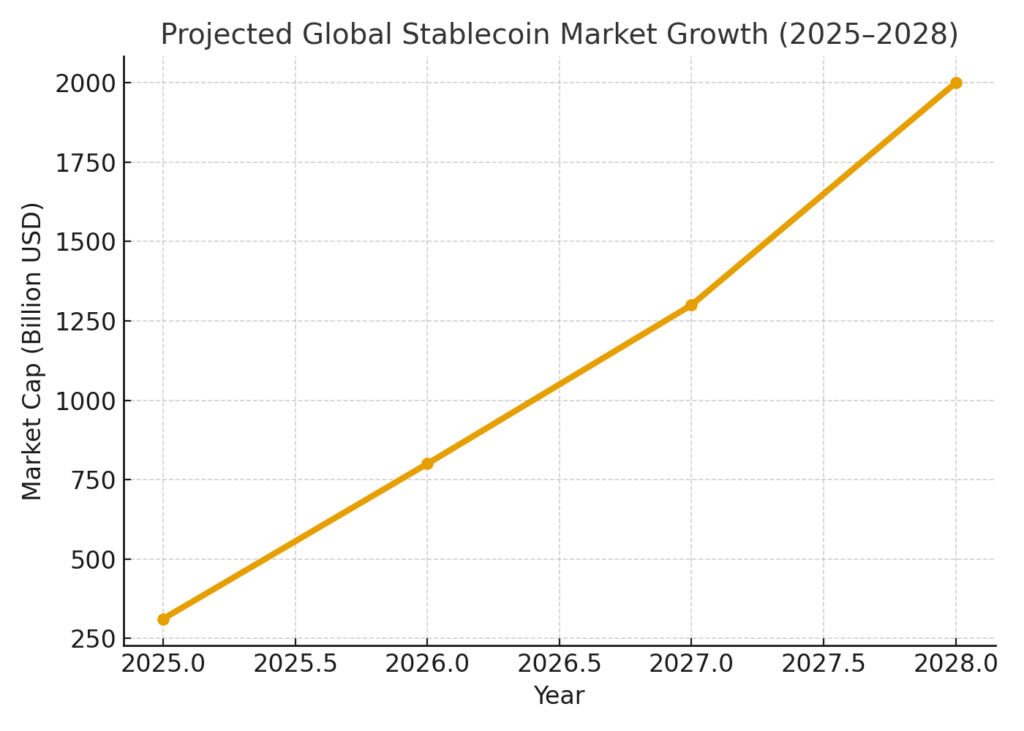
Key Points :
- Western Union (WU) is introducing a new U.S. dollar-pegged stablecoin named USDPT, to be issued on the Solana blockchain via Anchorage Digital Bank, scheduled for launch in the first half of 2026.
- WU will build a “Digital Asset Network” that functions as the cash off-ramp/on-ramp for users in more than 200 countries and 100 million+ customers, integrating the stablecoin into its global remittance infrastructure.
- The company selected Solana after evaluating multiple blockchains, citing its institutional-scale performance for stablecoin settlement.
- WU’s stablecoin initiative aligns with broader industry trends: stablecoins are expected to reach a market cap of up to ~US $2 trillion by 2028, driven by regulatory clarity and legacy payment firms adopting blockchain rails.
- For investors and crypto-asset hunters, WU’s move signals a major convergence of traditional remittance networks with crypto rails—presenting new opportunities for token utility, yield-bearing stablecoin structures, and real-world blockchain application.
1. A New Stablecoin Era for a Legacy Remittance Giant
In late October 2025, Western Union officially announced in its press release the forthcoming launch of its U.S. dollar-pegged stablecoin, USDPT, built on the Solana blockchain and issued in partnership with Anchorage Digital Bank. The company states the stablecoin will be available in the first half of 2026 and intends to integrate it into its global remittance and treasury infrastructure.
This is a compelling signal: a 175-year-old company known for cross-border money transfers is entering the stablecoin race not merely as a peripheral player, but as a core instrument of its payments business transformation. For readers seeking new crypto assets or blockchain-integration use cases, this is a strong indicator that stablecoins are migrating from niche utility toward mainstream finance.
2. Why Solana? The Infrastructure Choice
One of the compelling aspects of this development is the blockchain choice: Solana. During the announcement, WU’s CEO cited that after evaluating several blockchains, Solana offered the optimal combination of high throughput, low cost, and institutional-grade scalability for stablecoin settlement.

For crypto technologists and investors, this reveals how real-world payment systems are prioritizing latency, gas cost, and settlement finality—criteria that can help in assessing which blockchains will attract enterprise adoption. Furthermore, Solana’s ecosystem may gain additional utility and volume from this application, which could have downstream implications for SOL (Solana’s native token) and associated DeFi activity.
3. Digital Asset Network: Bridging Crypto and Fiat

Beyond issuing USDPT, Western Union is establishing a “Digital Asset Network” meant to act as a global cash off-ramp/on-ramp for digital assets. According to their statement, this network will integrate wallets, partner exchanges, and WU’s existing agent and retail infrastructure so users can send, receive, hold, and redeem USDPT seamlessly.
This is key for blockchain practitioners and crypto adopters alike: access and exit rails are often the bottleneck for utility tokens and stablecoins in real-world use cases. WU’s global footprint (200+ countries, 100 million+ customers) gives this initiative a credible runway. For someone seeking new revenue streams, the ability to move between fiat and stablecoin within a trusted global framework opens new business models (e.g., micro-remittances, on-chain wallet services, tokenised fiat payrolls).
4. Market Timing: The Regulatory & Industry Tailwinds

The timing of this move aligns with a broader macro backdrop: regulatory clarity in the U.S., increasing acceptance of stablecoins by legacy players, and forecasts projecting dramatic growth in the stablecoin market. For example:
- The U.S. Department of the Treasury and other institutions project that stablecoins could reach roughly US $2 trillion by 2028.
- At the same time, established remittance firms like Western Union recognise that blockchain rails offer faster settlement times, lower costs, and greater transparency versus traditional correspondent banking.
For crypto-asset seekers, this suggests stablecoins may not just be a back-office tool but a front-line profit engine—especially where tokenised fiat meets high-volume global payments.
5. Opportunity Map for Crypto Investors and Builders
From a practical blockchain perspective, what does WU’s announcement mean for those hunting new assets or building real-world utility?
- Token Utility & Adoption: USDPT could serve as a high-volume settlement token, driving real usage rather than speculative trading. This utility can underpin possible yield-bearing structures (e.g., disruption of treasury-backed token models).
- Ecosystem Spill-over: With Solana as the infrastructure, ancillary DeFi projects, wallet providers, and on-ramp/off-ramp services may benefit. Projects planning to build solutions that integrate WU’s rails (wallet SDKs, stablecoin gateways, treasury bridges) may capture early mover advantage.
- Remittance Innovation: Builders can design modules around micro-payments, merchant integration, cross-border payroll, and tokenised remittance flows leveraging USDPT as the settlement layer.
- Regulatory Advantage: Because Western Union partners with a federally-regulated issuer (Anchorage Digital Bank) and leverages compliance infrastructure, the project may set a template for compliant stablecoin issuance in other jurisdictions. This reduces regulatory risk for infrastructure builders.
For someone interested in practical blockchain applications and revenue generation, these are key takeaways: utility, infrastructure, compliance, and growth all converge.
6. Risks & Considerations
Of course, there are caveats that crypto-asset investors and builders need to bear in mind:
- While regulatory clarity is improving, actual usage of stablecoins for payments—rather than trading—remains modest. Some banks forecast much lower growth scenarios (e.g., J.P. Morgan projects only ~US $500 billion by 2028) which contrasts with more optimistic projections.
- Blockchain choice matters: while Solana offers speed and low cost, it also faces competition, network risk (congestion, downtime), and may need to demonstrate endurance at enterprise scale (handling 100 M+ users) in real time.
- Execution risk: Issuing the stablecoin is one step; driving on/off-ramp usage, regulatory compliance across 200+ jurisdictions, merchant adoption, and competing with existing rails are significant operational hurdles.
- Token economics: For builders/investors, how USDPT is distributed, whether it yields returns, and how it is integrated into the broader ecosystem will determine the upside. Non-yielding stablecoins may offer limited investment return beyond settlement volume adaptation.
7. Implications for Your Focus: New Crypto Assets, Income Streams & Blockchain Use-cases
Given your interest in new crypto assets, income opportunities, and practical blockchain applications, the WU-Solana stablecoin initiative presents several actionable angles:
- Asset Identification: USDPT itself may not be a speculative token, but its ecosystem (wallets, rails, on/off-ramp services) may spawn associated tokens or infrastructure projects. Monitor Solana-ecosystem tokens that integrate with WU’s rails.
- Income Opportunities: Builders could offer value-added services (e.g., transaction monitoring, cross-border payroll, micro-remittance apps) built atop USDPT rails and monetise via fee-sharing, DApp modules, or tokenized incentives.
- Blockchain Use-case Implementation: For your wallet project (‘dzilla Wallet’), this illustrates a blueprint: partnering or integrating with a major stablecoin on a high-throughput chain, delivering fiat-crypto interoperability, building on-ramp/off-ramp flows, and emphasising user experience in cross-border payments.
- Enterprise UX Transparency: The WU move emphasises transparency, regulatory compliance and user-friendly interfaces (send/receive/hold/redeem) in the stablecoin space. For builders / UX designers, this underscores that cryptocurrencies increasingly must deliver institutional-grade service experience—not just “speculate, hold, trade”.
Conclusion
Western Union’s decision to issue USDPT on Solana marks a seminal moment in crypto adoption: it bridges an institutional remittance giant with high-throughput blockchain infrastructure and regulatory compliance. For crypto investors, it highlights stablecoins’ migration from niche instruments to mainstream payment rails; for blockchain practitioners, it offers a tangible template for real-world settlement use cases and revenue-generating applications.
While risks remain—including usage scaling, regulatory execution and competitive infrastructure—the key take-away is that the era of truly interoperable, fiat-chain hybrid payments is accelerating. For those seeking new assets, income potential and practical blockchain implementation, the stablecoin-powered remittance vector is a compelling domain to explore.

